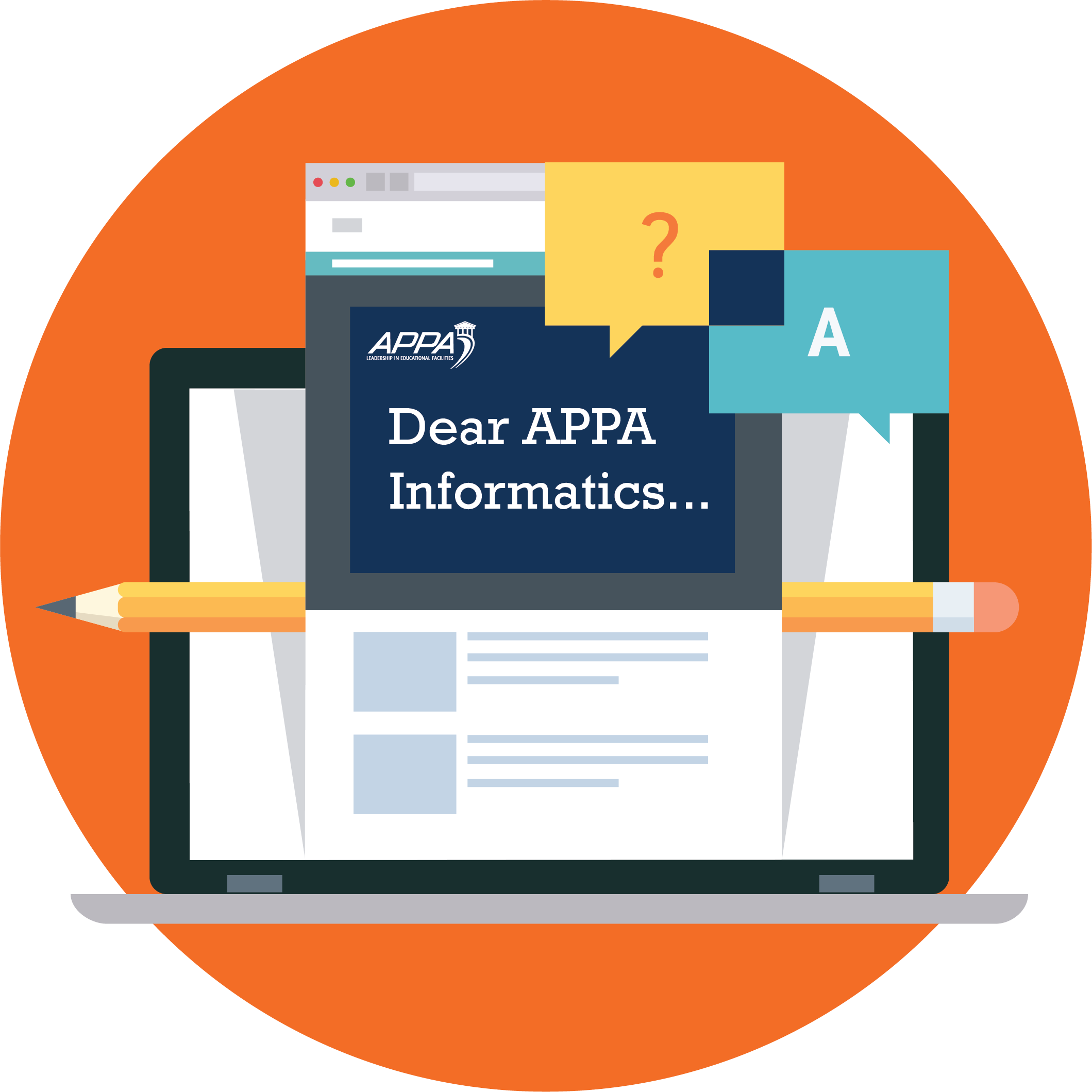
“Dear APPA Informatics: I am the new facility manager at Jellystone Idealized University responsible for the energy budget, among other things. Given the COVID pandemic, we had to rapidly change our HVAC systems to adjust to provide for increased air-change rates in many of our buildings. Because things happened so rapidly, we didn’t have time to build in robust, revised controls programming to account for empty spaces during the day or at night, meaning we are pushing energy right out our exhaust at unsustainable rates. Where should I look to get started on solving this problem?”—Jane Q. Public, Director of Facilities, JIU
If this is a question you have, then you’ve come to the right spot. But before we answer it, we want to introduce you to what APPA Facilities Informatics is looking to do through a periodic contribution to Facilities Manager magazine. Do you also have burning questions that you need answered? Do you want advice from the folks who know best? Well, we are launching a series of articles akin to the advice columns of yore, which we hope will help you answer your questions by leveraging the information you may already have.
How it Works
The APPA Facilities Informatics Working Group has been working over the last several years to spread the good word about this process. You may have seen articles such as Informatics Next Steps: A Journey to Better Knowledge or Informatics Moving Forward in Facilities Manager. Or you may have come to one of our sessions during an APPA Conference at the regional or national level. Or perhaps you’ve read the APPA Facilities Informatics Maturity Matrix Technical Report put out by the working group. And certainly you have also seen lots about APPA Facilities Performance Indicators (FPI) 2.0 and its next generation of analytical tools that will only seek to better the performance of those that partake year after year (Getting the Most out of APPA’s FPI Survey and Report Tool—And a Preview of What’s to Come).
All of these resources have brought to the fore the need to leverage data, information, knowledge, and wisdom to make our campuses safer, more effective and efficient, greener, and just better. To that end, the working group will be taking your questions and providing APPA membership with answers—and with advice on how best to find those answers yourselves. Inevitably, it is likely that by answering one of your questions or by helping one of our member colleges, universities, or schools through this public forum, we will also be able to help others.
How can you contribute? First, APPA has a great tool in the APPA365 app (available through your preferred app store), which includes a very helpful feature called “APPAexch” (short for APPA exchange). Feel free to put in your questions, comments, and thoughts there, addressed to Dear APPA Informatics. Second, in the not-too-distant future, APPA is going to roll out a set of tools to make collaboration across our amazing membership network even better. Be on the lookout for announcements about these new collaboration tools, which will also provide you additional ways to get to the APPA Facilities Informatics team and this Dear APPA Informatics series.
The Promise
As the APPA Facilities Informatics working group, we promise that we will do our best to get back to you as soon as we can. That said, we don’t know how many questions we will get or how much it might take to leverage the collective knowledge and wisdom of our team; so it may take a while. We will answer you however, somehow, in some way. Be on the lookout for some initial articles on various topics, such as how to leverage information you have now to determine the Total Cost of Ownership (TCO) for your assets, or how to drive down your overtime by understanding the data you already have at your fingertips. And if you think we have gotten something wrong, or if you have a comment to help the APPA membership, we will certainly welcome that input too.
And now back to the opening question of Jane Q. Public: The first thing we’d recommend is to look at which of your buildings have the largest energy use and start there (you probably already knew that). But as you do this, also touch base with your registrar and/or room reservation/scheduling groups about how you can determine what spaces are being used and when. It’s likely that we are going to have to rethink how to reduce energy use while also providing continued high levels of ventilation air changes for the foreseeable future (as the delta and forthcoming variants continue to course through the globe).
What will enable us to get back to a much more affordable path will be to gather usage data and calibrate HVAC to that data on an ongoing basis. This will need to be coupled with increased sensing (some amazing new air-quality sensors are now hitting the marketplace); filtration (UV and other tools, which many have already implemented); and occupancy control (security and sensing). As facility managers, we can more adroitly provide higher-quality ventilation while still gaining the efficiencies needed to get our energy budgets back in line (as well as meeting our still challenging climate/emissions goals).
With all of this in mind, we look forward to making this journey with you. Happy data hunting!
Erik Backus is director, construction engineering management at Clarkson University in Potsdam, NY, and can be reached at [email protected]. Markus Hogue is senior GIS analyst at the University of Texas at Austin and can be reached at [email protected].
Code Talkers
Code Talkers: Highlights the various codes, laws, and standards specific to educational facilities and explains the compliance issues and implications of enforcing these measures. To contribute, contact Kevin Willmann, FM Column Editor.
See all Code Talkers.


